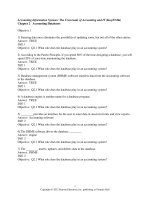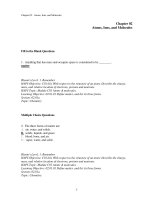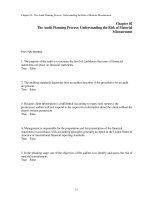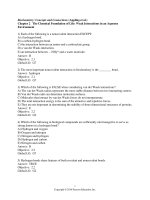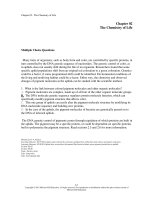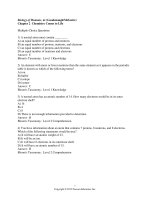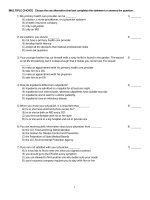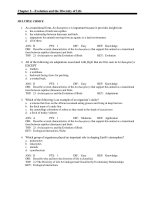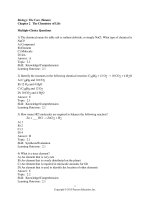Biology organisms and adaptations 1st edition noyd test bank
Bạn đang xem bản rút gọn của tài liệu. Xem và tải ngay bản đầy đủ của tài liệu tại đây (448.43 KB, 12 trang )
Chapter 2—Evolution and the Diversity of Life
MULTIPLE CHOICE
1. As a transitional form, Archaeopteryx is important because it provides insight into
a. the evolution of birds into reptiles.
b. the relationship between dinosaurs and birds.
c. adaptations for animals moving from an aquatic to a land environment.
d. all of these
ANS: B
PTS: 1
DIF: Easy
REF: Knowledge
OBJ: Describe several characteristics of the Archaeopteryx that support this animal as a transitional
form between reptiles (dinosaurs) and birds.
TOP: 2.1 Archaeopteryx and the Evolution of Birds
KEY: Evolution
2. All of the following are adaptations associated with flight that are first seen in Archaeopteryx
EXCEPT
a.
b.
c.
d.
feathers.
a wishbone.
backward facing claws for perching.
a toothed beak.
ANS: D
PTS: 1
DIF: Easy
REF: Knowledge
OBJ: Describe several characteristics of the Archaeopteryx that support this animal as a transitional
form between reptiles (dinosaurs) and birds.
TOP: 2.1 Archaeopteryx and the Evolution of Birds
KEY: Adaptations
3. Which of the following is an example of an organism’s niche?
a. a tortoise that lives on the African savannah eating grasses and living in deep burrows
b. the thick mane of a male lion
c. the camouflage coloration of zebras as they stand in the shade of acacia trees
d. a flock of turkey vultures
ANS: A
PTS: 1
DIF: Moderate
REF: Application
OBJ: Describe several characteristics of the Archaeopteryx that support this animal as a transitional
form between reptiles (dinosaurs) and birds.
TOP: 2.1 Archaeopteryx and the Evolution of Birds
KEY: Ecological interactions; Niche
4. Which group of organisms played an important role in shaping Earth’s atmosphere?
a. prokaryotes
b. eukaryotes
c. animals
d. cyanobacteria
ANS:
OBJ:
TOP:
KEY:
D
PTS: 1
DIF: Easy
REF: Knowledge
Describe why and how the diversity of life is classified.
2.2 The Diversity of Life Is Cataloged and Classified by Evolutionary Relationships
Ecological interactions
5. What role did cyanobacteria play in shaping Earth’s environment?
a. They are single-celled organisms that are detritivores.
b. They produced oxygen, which led to changes in Earth’s atmosphere.
c. They evolved into the first plants that colonized land.
d. They are the ancestral form of all life on Earth.
ANS:
OBJ:
TOP:
KEY:
B
PTS: 1
DIF: Easy
REF: Comprehension
Describe why and how the diversity of life is classified.
2.2 The Diversity of Life Is Cataloged and Classified by Evolutionary Relationships
Ecological interactions
6. As prokaryotes, which structure is found in cyanobacteria?
a. nucleoid
b. mitochondrion
c. nucleus
d. all of these
ANS:
OBJ:
TOP:
KEY:
A
PTS: 1
DIF: Easy
REF: Analysis
Describe why and how the diversity of life is classified.
2.2 The Diversity of Life Is Cataloged and Classified by Evolutionary Relationships
Cell types
7. Which structure originated from cyanobacteria?
a. A
b. B
c. C
d. D
ANS:
OBJ:
TOP:
KEY:
A
PTS: 1
DIF: Moderate
REF: Application
Describe why and how the diversity of life is classified.
2.2 The Diversity of Life Is Cataloged and Classified by Evolutionary Relationships
Cell structure and function
NOT: Figure 2.22a
8. Which of the following correctly lists the terms in hierarchical order from the most inclusive
to the least inclusive?
a.
b.
c.
d.
kingdom, domain, class, phylum
species, kingdom, order, family
class, order, family, genus
order, phylum, family, species
ANS:
OBJ:
TOP:
KEY:
C
PTS: 1
DIF: Easy
REF: Comprehension
Describe why and how the diversity of life is classified.
2.2 The Diversity of Life Is Cataloged and Classified by Evolutionary Relationships
Hierarchy
9. All living organisms
a. belong to one of three domains.
b. belong to the same kingdom.
c. belong to the domain Eukarya.
d. are composed of the same type of cell..
ANS:
OBJ:
TOP:
KEY:
A
PTS: 1
DIF: Easy
REF: Comprehension
Describe why and how the diversity of life is classified.
2.2 The Diversity of Life Is Cataloged and Classified by Evolutionary Relationships
Hierarchy
10. Two organisms are very similar both in terms of molecular and physical characteristics.
However, there is at least one characteristic that is not shared by these organisms—each
organism has at least one evolutionary novelty that is not present in the other organism and
thus these organisms do not interbreed. As a result, what is likely the lowest taxonomic
classification that is shared by these organisms?
a.
b.
c.
d.
species
genus
family
order
ANS:
OBJ:
TOP:
KEY:
B
PTS: 1
DIF: Moderate
REF: Analysis
Describe why and how the diversity of life is classified.
2.2 The Diversity of Life Is Cataloged and Classified by Evolutionary Relationships
Hierarchy
11. Which of the following domains contain prokaryotic cells?
a. Archaea and Bacteria
b. Eukarya and Archaea
c. Bacteria and Eukarya
d. Archaea, Bacteria, and Eukarya
ANS:
OBJ:
TOP:
KEY:
A
PTS: 1
DIF: Easy
REF: Knowledge
Describe why and how the diversity of life is classified.
2.2 The Diversity of Life Is Cataloged and Classified by Evolutionary Relationships
Hierarchy
12. Which of the following groups share the characteristic of having an amniotic sac or egg?
a. amphibians, mammals, and crocodiles
b. sharks, amphibians, and ray-finned fishes
c. mammals, crocodiles, and reptiles/birds
d. reptiles/birds, crocodiles, and amphibians
ANS:
OBJ:
TOP:
KEY:
C
PTS: 1
DIF: Easy
REF: Comprehension
Describe why and how the diversity of life is classified.
2.2 The Diversity of Life Is Cataloged and Classified by Evolutionary Relationships
Phylogeny
NOT: Figure 2.12
13. Which characteristic is common to all groups represented on this evolutionary tree?
a. vertebrae
b. bony skeleton
c. four limbs
d. amniotic egg or sac
ANS:
OBJ:
TOP:
KEY:
A
PTS: 1
DIF: Easy
REF: Comprehension
Describe why and how the diversity of life is classified.
2.2 The Diversity of Life Is Cataloged and Classified by Evolutionary Relationships
Phylogeny
NOT: Figure 2.12
14. Based on the evolutionary tree, which domain is most closely related to animals?
a. Prokaryotes
b. Eukaryotes
c. Archaea
d. Bacteria
ANS:
OBJ:
TOP:
KEY:
C
PTS: 1
DIF: Moderate
REF: Analysis
Describe why and how the diversity of life is classified.
2.2 The Diversity of Life Is Cataloged and Classified by Evolutionary Relationships
Phylogeny
NOT: Figure 2.15
15. Based on the evolutionary tree, which letter represents the common ancestor of animals and
fungi?
a.
b.
c.
d.
A
B
C
D
ANS:
OBJ:
TOP:
KEY:
D
PTS: 1
DIF: Moderate
REF: Analysis
Describe why and how the diversity of life is classified.
2.2 The Diversity of Life Is Cataloged and Classified by Evolutionary Relationships
Phylogeny
NOT: Figure 2.15
16. Based on the evolutionary tree, which letter represents the common ancestor of all
eukaryotes?
a.
b.
c.
d.
A
B
C
D
ANS:
OBJ:
TOP:
KEY:
A
PTS: 1
DIF: Moderate
REF: Analysis
Describe why and how the diversity of life is classified.
2.2 The Diversity of Life Is Cataloged and Classified by Evolutionary Relationships
Phylogeny
NOT: Figure 2.15
17. Despite the variety of sizes, shapes, and colors, a male German Shepherd and a Great Dane
(two breeds of dogs) can mate with one another and produce offspring. Do these dogs belong
to the same species?
a.
b.
c.
d.
yes, because they can interbreed
no, because they each have evolutionary novelties not shared by the other breed
no, because they are different dog breeds
yes, because they share physical similarities
ANS:
OBJ:
TOP:
KEY:
A
PTS: 1
DIF: Moderate
REF: Application
Describe why and how the diversity of life is classified.
2.2 The Diversity of Life Is Cataloged and Classified by Evolutionary Relationships
Hierarchy
18. All life can be divided into _____ domains and _____ kingdoms.
a. three; three
b. four; four
c. three; four
d. four; three
ANS:
OBJ:
TOP:
KEY:
C
PTS: 1
DIF: Easy
REF: Knowledge
Discuss the basic characteristics of animals, plants, fungi, and protists.
2.3 Animals, Plants, Fungi, and Protists Are Classified in the Domain Eukarya
Hierarchy
19. A researcher is studying a parasitic bacterium that produces toxins that can harm its host.
Thus, the researcher is studying a(n)
a.
b.
c.
d.
heterotrophic eukaryote.
autotrophic eukaryote.
heterotrophic prokaryote.
autotrophic prokaryote.
ANS:
OBJ:
TOP:
KEY:
C
PTS: 1
DIF: Easy
REF: Application
Discuss the basic characteristics of animals, plants, fungi, and protists.
2.3 Animals, Plants, Fungi, and Protists Are Classified in the Domain Eukarya
Ecological interactions
20. Which of the following characteristics apply to animals?
a. heterotroph only
b. heterotroph, producer
c. heterotroph, multicellular
d. heterotroph, producer, multicellular, cell wall
ANS:
OBJ:
TOP:
KEY:
C
PTS: 1
DIF: Easy
REF: Comprehension
Discuss the basic characteristics of animals, plants, fungi, and protists.
2.3 Animals, Plants, Fungi, and Protists Are Classified in the Domain Eukarya
Ecological interactions
21. Which of the following characteristics apply to plants?
a. producer only
b. heterotroph, producer
c. producer, multicellular, cell wall
d. heterotroph, producer, multicellular, cell wall
ANS:
OBJ:
TOP:
KEY:
C
PTS: 1
DIF: Easy
REF: Comprehension
Discuss the basic characteristics of animals, plants, fungi, and protists.
2.3 Animals, Plants, Fungi, and Protists Are Classified in the Domain Eukarya
Ecological interactions
22. Which of the following characteristics apply to fungi?
a. heterotroph only
b. heterotroph, producer
c. heterotroph, multicellular, cell wall
d. heterotroph, producer, multicellular, cell wall
ANS:
OBJ:
TOP:
KEY:
C
PTS: 1
DIF: Easy
REF: Comprehension
Discuss the basic characteristics of animals, plants, fungi, and protists.
2.3 Animals, Plants, Fungi, and Protists Are Classified in the Domain Eukarya
Ecological interactions
23. Which of the following are heterotrophic eukaryotes with a cell wall?
a. ferns
b. mosses
c. mushrooms
d. orchids
ANS:
OBJ:
TOP:
KEY:
C
PTS: 1
DIF: Easy
REF: Application
Discuss the basic characteristics of animals, plants, fungi, and protists.
2.3 Animals, Plants, Fungi, and Protists Are Classified in the Domain Eukarya
Ecological interactions
24. All of the following statements are true about organisms that photosynthesize EXCEPT:
a. They are called producers.
b. They are able to convert the sun’s energy into a different form of energy.
c. They release oxygen.
d. They are all eukaryotes.
ANS:
OBJ:
TOP:
KEY:
D
PTS: 1
DIF: Easy
REF: Comprehension
Discuss the basic characteristics of animals, plants, fungi, and protists.
2.3 Animals, Plants, Fungi, and Protists Are Classified in the Domain Eukarya
Photosynthesis
25. As producers, what inputs do plants require for the process of photosynthesis?
a. oxygen and sunlight
b. oxygen and carbon dioxide
c. carbon dioxide and sunlight
d. carbon dioxide, oxygen, and sunlight
ANS:
OBJ:
TOP:
KEY:
C
PTS: 1
DIF: Easy
REF: Knowledge
Discuss the basic characteristics of animals, plants, fungi, and protists.
2.3 Animals, Plants, Fungi, and Protists Are Classified in the Domain Eukarya
Photosynthesis
26. Both plant and animal cells have all the following structures EXCEPT
a. a cell membrane.
b. a nucleus.
c. mitochondria.
d. chloroplasts.
ANS:
OBJ:
TOP:
KEY:
D
PTS: 1
DIF: Easy
REF: Knowledge
Discuss the basic characteristics of animals, plants, fungi, and protists.
2.3 Animals, Plants, Fungi, and Protists Are Classified in the Domain Eukarya
Cell types
27. Which of the following characteristics are shared by cells found in both plants and fungi?
a. cell wall
b. chloroplast
c. photosynthesis
d. all of these
ANS:
OBJ:
TOP:
KEY:
A
PTS: 1
DIF: Easy
REF: Knowledge
Discuss the basic characteristics of animals, plants, fungi, and protists.
2.3 Animals, Plants, Fungi, and Protists Are Classified in the Domain Eukarya
Cell types
28. The portion of a mushroom that you typically eat is
a. the fruiting body.
b. the reproductive structure.
c. the chytrid sac.
d. both the fruiting body and the reproductive structure.
ANS:
OBJ:
TOP:
KEY:
D
PTS: 1
DIF: Easy
REF: Knowledge
Discuss the basic characteristics of animals, plants, fungi, and protists.
2.3 Animals, Plants, Fungi, and Protists Are Classified in the Domain Eukarya
Ecological interactions
29. All of the following are beneficial characteristics of fungi EXCEPT:
a. They decompose and recycle dead matter.
b. They are a source of medicines.
c. They are producers that release oxygen.
d. They are a food source.
ANS:
OBJ:
TOP:
KEY:
C
PTS: 1
DIF: Easy
REF: Knowledge
Discuss the basic characteristics of animals, plants, fungi, and protists.
2.3 Animals, Plants, Fungi, and Protists Are Classified in the Domain Eukarya
Ecological interactions
30. Which of the following is not true of protists as a group?
a. They are all single-celled.
b. They are eukaryotes.
c. They range in size from microscopic to large multicellular organisms.
d. They likely belong to multiple kingdoms.
ANS:
OBJ:
TOP:
KEY:
A
PTS: 1
DIF: Easy
REF: Knowledge
Discuss the basic characteristics of animals, plants, fungi, and protists.
2.3 Animals, Plants, Fungi, and Protists Are Classified in the Domain Eukarya
Cell types
31. Protists are currently divided into informal groups based on their similarity to other kingdoms.
A protist that is a decomposer is categorized as a(n) __________ protist.
a.
b.
c.
d.
animal-like
plantlike
funguslike
autotrophic
ANS:
OBJ:
TOP:
KEY:
C
PTS: 1
DIF: Easy
REF: Knowledge
Discuss the basic characteristics of animals, plants, fungi, and protists.
2.3 Animals, Plants, Fungi, and Protists Are Classified in the Domain Eukarya
Cell types
32. This organism lives in an aquatic environment and is a eukaryotic heterotroph without any
cell walls. What kingdom does it likely belong to?
a.
b.
c.
d.
animals
fungi
plants
archaea
ANS:
OBJ:
TOP:
KEY:
A
PTS: 1
DIF: Easy
REF: Analysis
Discuss the basic characteristics of animals, plants, fungi, and protists.
2.3 Animals, Plants, Fungi, and Protists Are Classified in the Domain Eukarya
Hierarchy
33. All of the following are true about prokaryotic cells EXCEPT:
a. Prokaryotic cells are smaller than eukaryotic cells.
b. They do not contain DNA.
c. They have no membrane-bound organelles.
d. They have ribosomes and a cell membrane.
e. They are found in two domains: Bacteria and Archaea.
ANS:
OBJ:
TOP:
KEY:
B
PTS: 1
DIF: Easy
REF: Knowledge
Discuss the basic characteristics of prokaryotic organisms.
2.4 Bacteria and Archaea Are Prokaryotic Microorganisms
Cell types
34. Bacteria and Archaea
a. belong to the same domain.
b. have similar cellular structures.
c. have cell walls that are structurally similar to plant cell walls.
d. are more closely related to each other than to eukaryotes.
ANS:
OBJ:
TOP:
KEY:
B
PTS: 1
DIF: Easy
REF: Knowledge
Discuss the basic characteristics of prokaryotic organisms.
2.4 Bacteria and Archaea Are Prokaryotic Microorganisms
Hierarchy
Insects and bacteria appear to team up against a pesticide that is commonly sprayed on crops.
The bean bug Riptortus pedestris is a common soybean pest and in a recent study was shown
to acquire resistance to a common insecticide. This resistance is related to the presence of
bacteria (Burkholderia sp.) living within its gut. In this mutually beneficial relationship, more
than 100 million bacteria can live within the insect’s gut. Evidence suggests that these bacteria
are able to break down the pesticide into carbon dioxide, which is used by the bacteria, and
harmless waste products are then secreted. In a recent study, researchers fed bacteria-infested
bean bugs and bacteria-free bean bugs a diet of soybean seedlings that had been treated with
the pesticide. Most of the bacteria-infested bean bugs survived after eating the treated
soybeans, but 80 percent of the bacteria-free bean bugs died.
35. In the study using bean bugs, soybeans and Burkholderia bacteria, how many domains are
represented?
a.
b.
c.
d.
one
two
three
four
ANS:
OBJ:
TOP:
KEY:
B
PTS: 1
DIF: Easy
REF: Application
Describe why and how the diversity of life is classified.
2.2 The Diversity of Life Is Cataloged and Classified by Evolutionary Relationships
Hierarchy
36. Carbon dioxide, which is a breakdown product of the pesticide, is likely used by the bacteria
for which of the following?
a.
b.
c.
d.
an energy source
cell structure
to carry genetic information
both an energy source and cell structure
ANS:
OBJ:
TOP:
KEY:
D
PTS: 1
DIF: Moderate
REF: Application
Describe why and how the diversity of life is classified.
2.2 The Diversity of Life Is Cataloged and Classified by Evolutionary Relationships
Cell structure and function
37. Of the organisms mentioned in this study, which is an autotroph?
a. soybeans
b. bacteria
c. bean bugs
d. both bacteria and bean bugs
ANS:
OBJ:
TOP:
KEY:
A
PTS: 1
DIF: Easy
REF: Comprehension
Discuss the basic characteristics of animals, plants, fungi, and protists.
2.3 Animals, Plants, Fungi, and Protists Are Classified in the Domain Eukarya
Ecological interactions
38. In the experiment, what would be considered the control group?
a. the bacteria-free bean bugs
b. the bacteria-infested bean bugs
c. the use of pesticides on the soybean plants
d. the number of deaths caused by eating the plants
ANS: A
PTS: 1
DIF: Moderate
REF: Application
OBJ: Describe the process of science, including how scientists use evidence to answer questions
about life.
TOP: 1.5 Biologists Use Evidence to Answer Questions about the Living World
KEY: Scientific method
39. Together, the bean bugs and the bacteria living within their gut would be considered a(n)
a. organism.
b. population.
c. community.
d. ecosystem.
ANS:
OBJ:
TOP:
KEY:
C
PTS: 1
DIF: Easy
REF: Application
Describe why and how the diversity of life is classified.
2.2 The Diversity of Life Is Cataloged and Classified by Evolutionary Relationships
Ecological interactions
40. Which of the following term(s) likely apply to the pesticide?
a. macromolecule
b. nucleic acid
c. inorganic molecule
d. nucleic acid and inorganic molecule
ANS:
OBJ:
TOP:
KEY:
A
PTS: 1
DIF: Moderate
REF: Analysis
Explain how organisms are systems of complex interactions at all levels of hierarchy.
1.3 Organisms Are Complex Interactive Systems at All Levels of Organization
Macromolecules
41. In an agricultural field where pesticides are regularly sprayed, there are always some insects
that survive due to some innate resistance based on their genetic makeup. These are the ones
that then reproduce so that in future generations there are more insects/pests that are resistant
to the pesticides. Over time, this may give rise to an entire population that is resistant to the
pesticide. This is an example of
a.
b.
c.
d.
homology.
natural selection.
experimentation.
classification.
ANS:
OBJ:
TOP:
KEY:
B
PTS: 1
DIF: Moderate
REF: Application
Describe how the unity and diversity of life are explained by evolution.
1.4 The Unity and Diversity of Life Are Explained By Evolution
Evolution; Natural selection
MATCHING
Match the following characteristic to the appropriate organism(s).
a.
b.
c.
d.
e.
1.
2.
3.
4.
5.
cell wall
chloroplast
nucleoid
ribosomes
heterotroph
bacteria and soybean
bacteria only
bacteria, soybean, and bean bug
bacteria and bean bug
soybean only
1. ANS:
OBJ:
TOP:
KEY:
2. ANS:
OBJ:
TOP:
KEY:
3. ANS:
OBJ:
TOP:
KEY:
4. ANS:
OBJ:
TOP:
KEY:
5. ANS:
OBJ:
TOP:
KEY:
A
PTS: 1
DIF: Moderate
REF: Application
Describe why and how the diversity of life is classified.
2.2 The Diversity of Life Is Cataloged and Classified by Evolutionary Relationships
Cell structure and function
C
PTS: 1
DIF: Moderate
REF: Application
Discuss the basic characteristics of prokaryotic organisms.
2.4 Bacteria and Archaea Are Prokaryotic Microorganisms
Cell structure and function
D
PTS: 1
DIF: Moderate
REF: Application
Discuss the basic characteristics of prokaryotic organisms.
2.4 Bacteria and Archaea Are Prokaryotic Microorganisms
Cell structure and function
E
PTS: 1
DIF: Moderate
REF: Application
Discuss the basic characteristics of animals, plants, fungi, and protists.
2.3 Animals, Plants, Fungi, and Protists Are Classified in the Domain Eukarya
Cell structure and function
B
PTS: 1
DIF: Moderate
REF: Application
Describe why and how the diversity of life is classified.
2.2 The Diversity of Life Is Cataloged and Classified by Evolutionary Relationships
Cell structure and function
